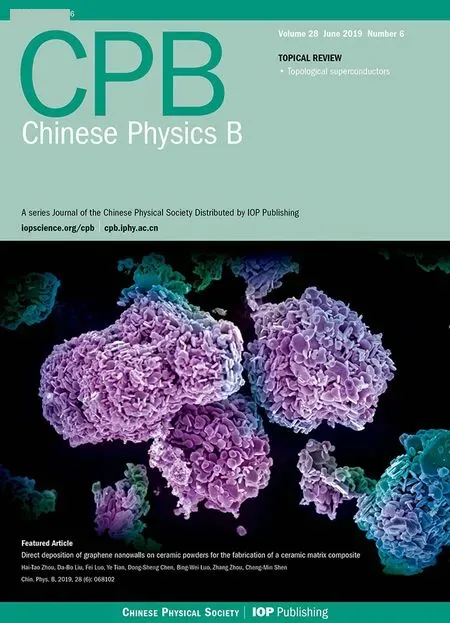Theoretical study of overstretching DNA-RNA hybrid duplex?
Dong-Ni Yang(楊東尼),Zhen-Sheng Zhong(鐘振聲),Wen-Zhao Liu(劉文釗),Thitima Rujiralai,and Jie Ma(馬杰),?
1School of Physics,Sun Yat-sen University,Guangzhou 510275,China
2State Key Laboratory of Optoelectronic Materials and Technologies,Sun Yat-sen University,Guangzhou 510006,China
3Department of Chemistry,Center of Excellence for Innovation in Chemistry,Faculty of Science,Prince of Songkla University,Songkhla 90112,Thailand
Keywords:DNA-RNA hybrid,mechanical properties,overstretching,thermodynamic and kinetic model
1.Introduction
DNA-RNA hybrid (DRH) duplex is an important element in various biological processes such as transcription,reverse transcription[1]and gene editing.[2]It also plays essential roles in replication initiation,[3]gene regulation,[4]chromosome segregation,[5]DNA repair,[6]DNA methylation,[7]telomere elongation,[8]etc.In addition,the DRH duplex is also used in some biotechnologies such as antisense therapy,[9]and is related to human diseases including neurological disorders.[10]
Despite its signi ficance,the mechanical properties of DRH have not been well characterized until very recently.Using magnetic tweezers,Zhang et al.[11]have measured the elasticity and the overstretching transitions of a single DRH molecule.Although the thermal stability of DRH[12-15]as well as its structure[16-19](which lies between A-form and B-form)has been reported previously,single molecule stretching experiments can measure the force-extension relationship of DRH and thus provide a more direct and quantitative way to characterize its mechanical properties.Yet,to better understand the single molecule experimental data and,furthermore,to predict some mechanical properties of DRH which may not have even been experimentally explored,a theoretical investigation is clearly valuable and demanding.
In this paper,using both thermodynamic and kinetic model,we investigate the competition among different processes,e.g.,S-form transition,unpeeling and bubbling which may occur in DRH overstretching as shown in Fig.1.The results are also compared with double-stranded DNA(dsDNA)in order to incorporate the mechanical properties of DRH into a biologically relevant force scale.
2.Theoretical model
We refer to a theoretical model previously proposed by Cocco et al.[20]to study the mechanical overstretching of ds-DNA and extend it to describe the overstretching of DRH with the newly measured elastic parameters.For tension-driven experiments,the free energy per base pair at a given force can be described by the integration of extension from force-extension data as follows:

Here,f is the applied force and x is the extension.This formula can be applied to DRH,dsDNA,single-stranded DNA(ssDNA)or single-stranded RNA(ssRNA)as long as the force-extension curve is known. Zhang et al.[11]has recently shown that the force-extension response of doublehelix DRH[21]can be described by the extensible worm-like chain(WLC)model before the overstretching transition oc-curs as follows:

In our model,we set persistence length Lp=50 nm,contour length L0=0.3 nm/bp,and stretching modulus K=660 pN for DRH at 1-M NaCl,25°C.It is worth noting that though these numbers are taken from Zhang et al.’s experiments,they are measured under a slightly different condition,i.e.,500-mM NaCl,22°C.
Zhang et al.have also shown that in the force region of 57-72 pN,DRH molecule underwent the structural transition and transformed from double helix form to S form,which,similar to the S form of dsDNA or double-stranded RNA(dsRNA),[22]is extended form of DRH with base-pairing retained as shown in Fig.1(b).
To describe the force-extension response at the doublehelix to S-form transition stage and later the S-form stretching stage,we make an approximation that the extension of DRH is linearly dependent on force in these two scenarios but with different slopes,S1and S2.The extension of DRH as a function of force at the double-helix to S-form transition stage thus can be written as

The value of S1can be obtained from the slope of the line determined by the onset point(x0=0.33 nm/bp,f0=57 pN)and terminal point(x1=0.48 nm/bp,f1=72 pN)of this transition from the experiment.Similarly,at the S-DRH stretching stage,the extension can be written as

where S2=(400/0.3)pN/nm,is the slope from a linear fitting of the experimental data from stretching S-DRH.Combining Eqs.(3)and(4)with Eq.(1),the force-dependent free energy for DRH in the transition and S-form stretching regions can be expressed,respectively,as

In order to discuss the free energy of tension-driven unpeeling(Figs.1(c)and 1(d))or bubbling(Fig.1(e))of DRH,we describe the extension of ssDNA as a function of force by using a phenomenological model[20]

where h=0.34 nm,a1=0.21,a2=0.34,f1=0.0037 pN,f2=2.9 pN,f3=8000 pN,and a3=2.973 at 1-M NaCl.For ssRNA,we use an extensible WLC model(see Eq.(2))to describe its extension response to force with Lp=0.75 nm,L0=0.59 nm/bp,and K=2000 pN.[23]Finally,the free energy of DRH after being unpeeled can be obtained from the numerical integration Eq.(1)with either the expression of xssDNA(f)or xssRNA(f),depending on which strand is left with tension as shown in Figs.1(c)and 1(d).We thus defi ne DRH before being unpeeled in Fig.1(c)as DNA-strandstressed DRH because in this case the force is directly applied to DNA strand of DRH.Similarly,we can also de fine DRH in Fig.1(d)as RNA-strand-stressed DRH.Notice that after being unpeeled,the strand that gets unpeeled will become relaxed and hence is assumed to make no contribution to the free energy calculation in our current model.
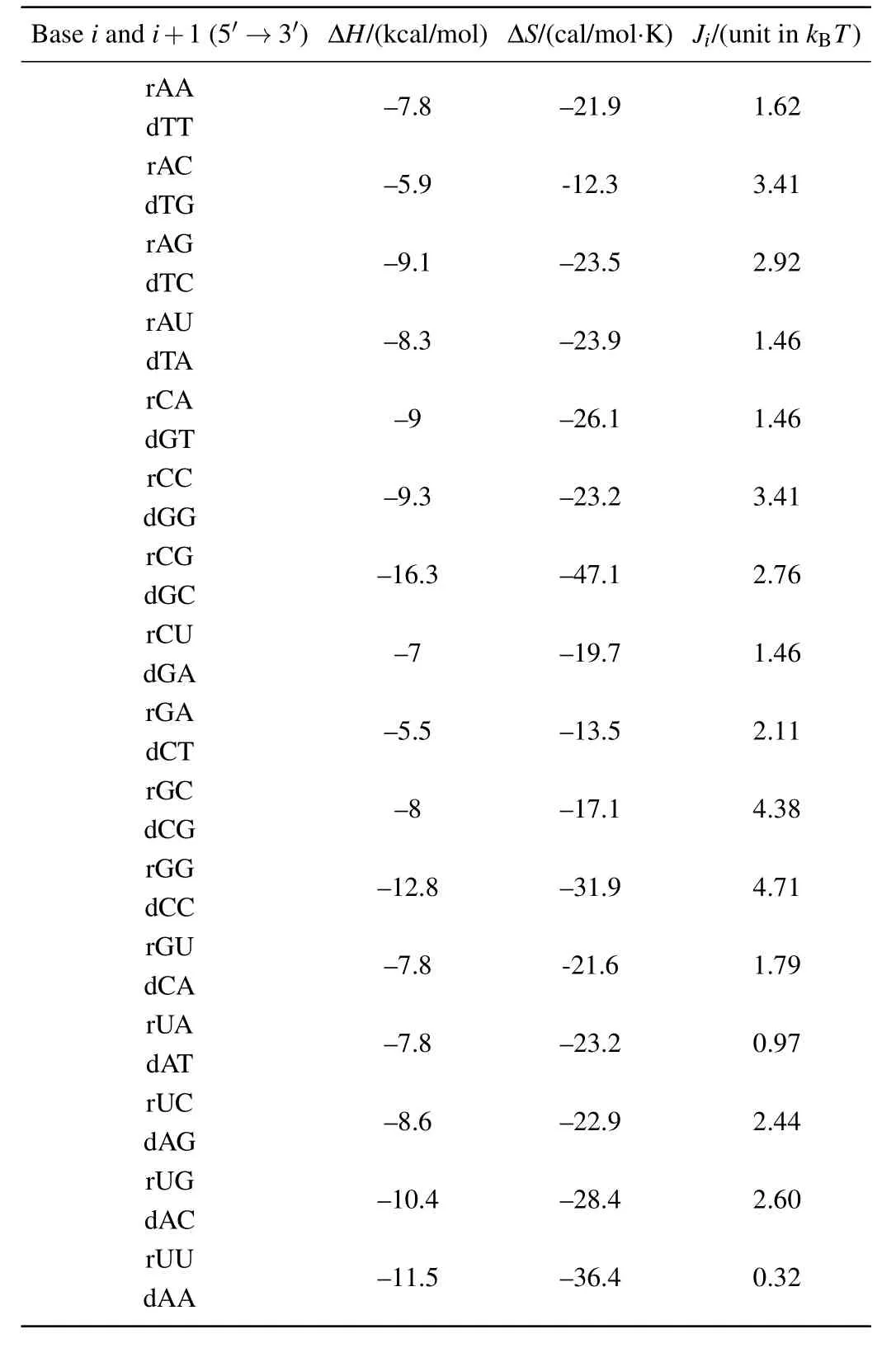
Table 1.Base-pairing-stacking free energy of hybrid duplex from Sugimoto et al.[24]for 25°C,1-M NaCl.
In addition,to make a comparison of relative free energy between single-stranded form and double helix form,we must consider the base-pairing free energy g0,which has a positive value here to denote the energy cost for opening one base-pa ir.It is noted that g0could have been estimated from DRH unzipping experiments,which have not been reported yet.Alternatively,we refer to the base-pairing-stacking energy from Sugimoto et al.,[24]under the nearest-neighboring approximationas shown in Table 1.Firstly,we can determine the value of g0by averaging the base-pairing-stacking energy of all the sequences given in Table 1.In such a way,the sequence effect is actually averaged out.Next,to investigate the sequence effect,we consider two extreme scenarios.One is the extremely GC rich sequence where we average all base-pairing free energy values of rGG,rGC,rCC,and rCG in Table 1 to give the GC-rich base-pairing free energy,g0,GC.The other is extremely AT(U)rich sequence where we average all base-pairing free energy values of rAA,rAU,rUU,and rUA in Table 1 to give the AU-rich base-pairing free energy,g0,AT.Similarly,we can also investigate the stability of DRH with either purine or pyrimidine rich sequence.
Next,we analyze the stabilities of different forms of DRH by calculating the relative free energy between them.In the DRH stretching experiment,when unpeeling happens,if the RNA strand gets unpeeled and the DNA strand is left with tension,as shown in Fig.1(c),then the free energy of such an unpeeled DRH(i.e.,ssDNA)relative to DRH in double helix form is given by

In a similar way,when the DNA strand of DRH gets unpeeled and the RNA strand is left with tension as shown in Fig.1(d),its free energy relative to double helix DRH is given by

Notice that here the positive ΔgssDNAtodhDRHand ΔgssRNAtodhDRHsuggest that single-stranded form is more favorable than double-helix form under such a tension.
To compare the stability of unpeeled DRH with that of DRH in S-form,the free energy of single-stranded form DNA or RNA relative to that of S-form DRH can be calculated as follows:

Again,the positive ΔgS-DRH to ssDNAand ΔgS-DRH to ssRNA suggest that single-stranded form is more stable than S form under the given force and hence is more favored.
To consider whether tension-driven bubbling(Fig.1(e))can happen in DRH stretching experiments,we treat the bubbled DRH as two parallel separated and non-interacting strands with the same extension but different tensions due to theirdifferentelasticities.ToobtaintheforceonssDNAstrand fssDNAand the force on ssRNA strand fssRNArespectively,we solve the equation xssDNA(fssDNA)=xssRNA(fssRNA)under the constraint that the total tension on DRH molecule is equal to the sum of the tensions each of which acts on a strand,i.e.,f=fssDNA+fssRNA.Its free energy relative to double helix form or S-form can then be written as

With Eqs.(8)-(13),we can then analyze the relative stability of different forms of DRH,determine which form is most favorable at a given force,and make a comparison of DRH with DNA.The sequence effect(such as GC-rich,AT-rich,pyrimidine-rich,and purine-rich sequence)can also be discussed.
Further,using a kinetic model,we can simulate and predict the force-extension response of DRH in its stretching and relaxation experiments.As tension increases,unpeeling can occur from the nicks on the strands or from the open ends of the strands as shown in Figs.1(c)and 1(d),and the forceextension response of the molecule during unpeeling is expected to give a rugged curve due to the abrupt jump between local minima separated by free energy barrier.[20]The pulling rate and temperature effects on the stretching and relaxation of DRH can also be investigated.The equations of the kinetic model are given by[20]
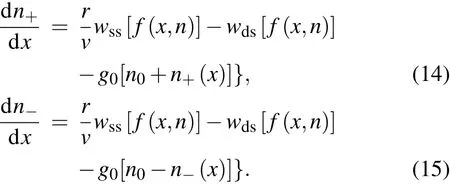
Here,r is the microscopic base-opening rate with a value of 108s-1.[20]Note that here it is assumed that the base-opening rate for DRH and DNA are the same,v is the pulling rate with positive value for stretching process and negative value for relaxation.g0[n0+n+(x)]and g0[n0-n-(x)]denote the free energy cost from opening n+or n-base-pairs counted from a nick at position n0either in the 5′→ 3′(“forward”)or in the opposite 3′→ 5′(“reverse”)direction.From Table 1 we can express g0[n0+n+(x)]and g0[n0-n-(x)]respectively as

and

where Jiis the sequence-dependent“stacking”free energy that depends on the base pair at sequence positions i and i+1 as shown in Table 1,C is the initial energy cost in opening the boundary base pair of DRH and its value 5.17kBT is used here.[24]
In addition,for simplicity,here we use wdsto denote any double stranded form of DRH and therefore,it depends on the force as expressed below.

The instantaneous equilibrium force,f(x,n),can be obtained from the following equation:

where n=n++n-is the total number of unpeeled base-pairs,N is the total base-pair number of DRH. Like the way of denoting wds,here xdscan be either the extension of DRH in double helix form at the transition stage,or in S form depending on the force,i.e.,

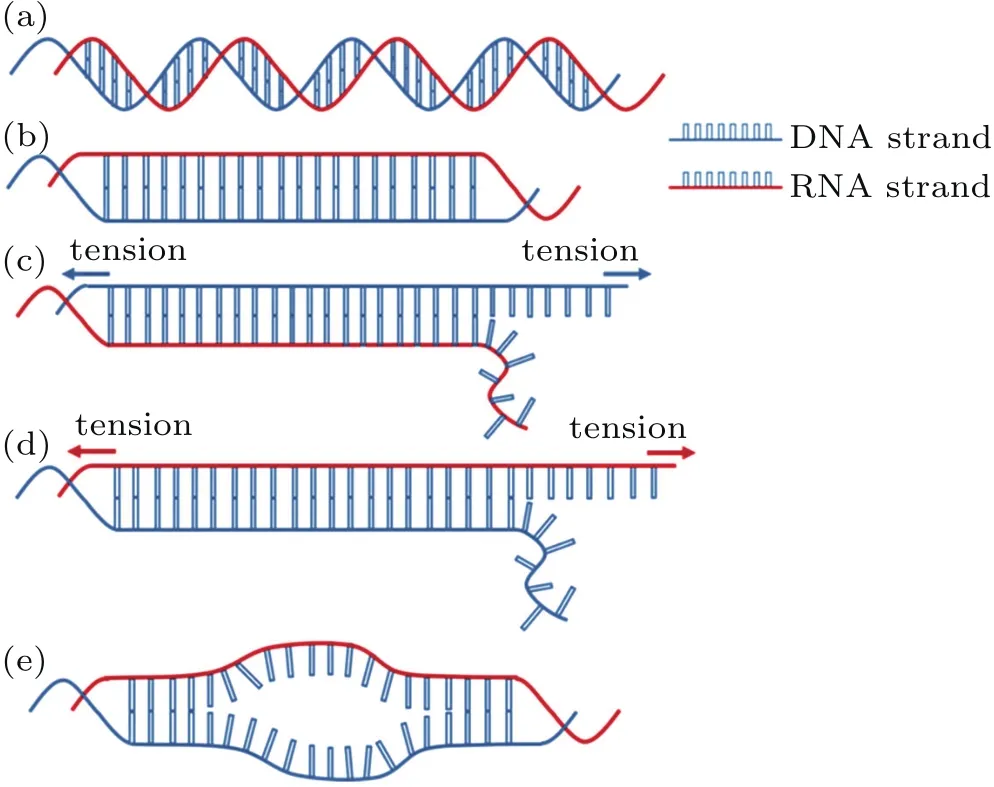
Fig.1.Illustration of possible forms of DRH in its overstretching experiment:(a)double-helix DRH,(b)S-DRH,(c)unpeeled DRH(DNA-strand-stressed),(d)unpeeledDRH(RNA-strand-stressed),and(e)bubbled DRH.
3.Results and discussion
In this section, we will present some representative results about the calculated free energy of DRH in its stretching experiment based on the model mentioned above.We will then discuss the overstretching thermodynamics of DRH and also make a comparison with double-helix DNA(i.e.,B-DNA).
We first calculate the force-dependent free energy of double-helix DRH and DNA as a function of stretching force using Eqs.(1)and(2).The results are shown in Fig.2.Interestingly,although double-helix DRH has a smaller stretching modulus(KDRH~660 pN)than double-helix DNA(KDNA~1300 pN),suggesting that double helix DRH should be more readily to stretch than DNA at high force,the calculated free energy of double-helix DRH shown in Fig.2 is actually smaller than that of DNA for the whole simulated force range.The reason lies in the fact that the DRH also has a smaller L0,which makes the integration in Eq.(1)for DRH finally less than that for DNA,i.e.,wdsDRH<wdsDNA.Therefore,stretching DRH to a given force will build up less elastic energy in the molecule when compared with DNA.
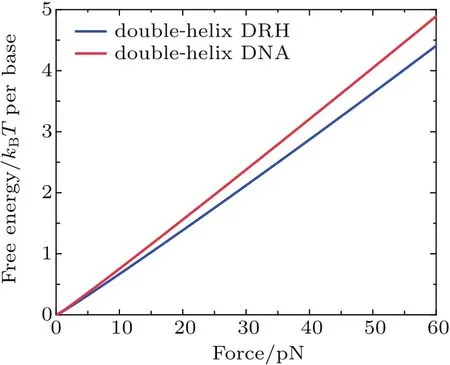
Fig.2.Free energy per base of double-helix DRH(wdhDRH)and doublehelix DNA(wdhDNA)as a function of force.
Figure 3 shows the calculated free energy of unpeeled DRH relative to two different ds-forms of DRH:double-helix form and S-form,under 1-M NaCl buffer condition at 25°C,with g0=3.04kBT from averaging all base-pair energy values in Table 1.It is remarkable that the relative free energy(so,the relative stability)of unpeeled DRH to its double-helix form exhibits quite different responses to force for DNA-strandstressed and RNA-strand-stressed DRH molecules.The reason for this difference lies in the fact that ssDNA and ss-RNA have different elasticities from each other.When DNA strand is left with tension,as long as F>69 pN,the ss-form DRH is more stable than the double-helix form as shown in Fig.3(a),but is less stable than S-form when F<76 pN as showninFig.3(b).Recallthatthetransitionfromdouble-helix form to S form for DRH occurs in a force range of 57 pN-72 pN.Therefore,without considering the sequence effect,the DNA-strand-stressed DRH will first undergo a transition from double-helix form to S form when the force changes between 57 pN and 72 pN.After that,further stretching DRH will lead to the unpeeling of its RNA-strand when F>76 pN.However,for the case of stretching RNA-strand-stressed DRH,the free energy of S-form remains larger than ss-form until the force reaches 167 pN,suggesting that the unpeeling is hard to happen under this scenario.As a conclusion,the DNA-strandstressed DRH is much easier to get unpeeled than the RNA-strand-stressed DRH.It should also be noted that the difference in free energy between S-DRH and ss-form DRH is not terribly large near the transition region especially for DNA-strand-stressed DRH.This suggests that the DRH unpeeling could easily happen during its overstretching transition if the salt concentration or pH value in the buffer decreases,or the temperature increases.These simulation results are consistent with the experimental observation from Zhang,et al.,where they found clearly the competition between S-form and ssform during overstretching transition under the low ionic concentration condition.
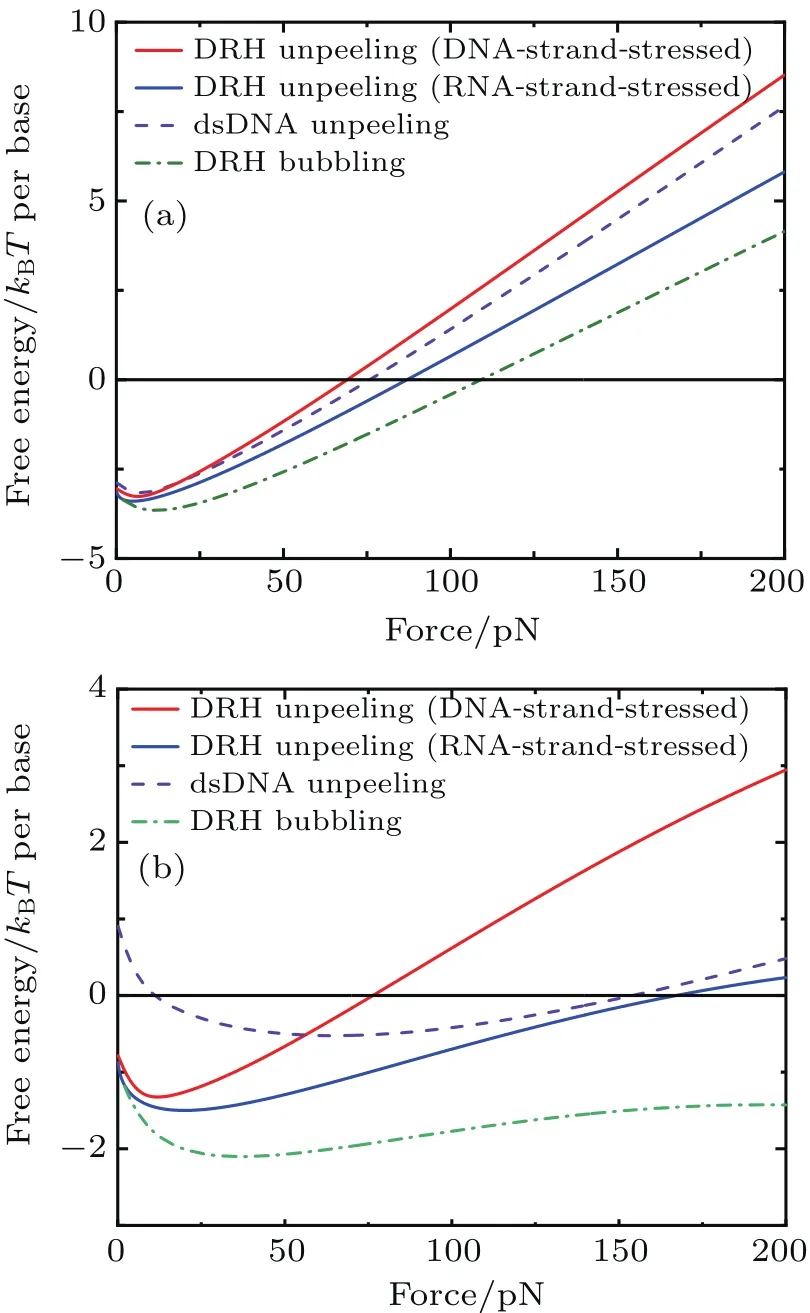
Fig.3.Free energy per base pair of unpeeled and bubbled DRH relative to(a)double-helix form DRH and(b)S-form DRH,with sequence effect averaged out.
It is also noticed in Fig.3(a)that in comparison with DNA,the RNA-strand-stressed DRH is dif ficult to unpeel due to its larger average base pairing energy.However,the DNA-strand-stressed DRH is easier to unpeel than the DNA.The reason is that in Eq.(8),even though g0for DNA is smaller than for DRH,the free energy wdsDNAis always larger than wdsDRHin the simulated force range as shown in Fig.2.Consequently,the final relative free energy of ssDNA to doublehelix DRH is larger than to DNA,meaning that unpeeling the DNA-strand-stressed DRH is easier than unpeeling the DNA.Inaddition, figure 3 also shows that tension induced DRH bubbling can hardly occur because either S-from or ss-form DRH is more favored than bubbled DRH over the whole force range(0 pN-200 pN)in our simulation.
In consideration of the sequence effect,we average the base-pairing free energy of rGG,rGC,rCC,and rCG of Table 1 to obtain g0,GC=4.58kBT for the extreme GC-rich sequence(Figs.4(a)and 4(b)),and average that of rAA,rAU,rUA,and rUU to obtain g0,AU=1.68kBT for the AT(U)-rich sequence(Figs.4(c)and 4(d)).As shown in Fig.4,for the extreme AT(U)-rich DRH,the unpeeling force decreases to 47 pN for the DNA-strand-stressed DRH and to 59 pN for the RNA-strand-stressed DRH,which are both below the starting force of double-helix and decrease to the S-form transition,i.e.,57 pN.Therefore,for the AT(U)-rich sequence,unpeeling is always more favored than S-form transition.In a sharp contrast,the extreme GC-rich DRH can hardly be unpeeled until 135 pN for DNA-strand-stressed DRH and will always more favor the S-form for RNA-strand-stressed DRH over the whole simulated force range.It is also noticed that the bubbled DRH is always less favored than unpeeled or S-form DRH even when the sequence is extremely AT(U)-rich.Putting all these results together,a picture of DRH stretching with the sequence effect considered can be described below.At low force,double-helix DRH is preferred.As force increases,the AT(U)-rich region starts to be unpeeled if there are nicks in that region or it is near the open ends of DRH.Otherwise,the DRH remains in the double-helix form until the force reaches to~57 pN.Then the transition from double-helix form to S-form occurs.Finally,at~72 pN,the whole sequences are converted partly into ss-form and partly into S-form.For the DNA-strand-stressed DRH,further stretching DRH to 135 pN will start to unpeel the left GC rich sequences as well as the possibly left AT(U)-rich sequences which could be sandwiched and protected by GC-rich sequences.For the RNAstrand-stressed DRH, the unpeeling will not happen even when the force rises up to 200 pN.The sequence thus plays a significant role in determining the overstretching pathways of DRH.Recently,by combining the fluorescence with optical tweezers,King et al.[25]were able to stretch a single DNA molecule and visualize its structure transitions simultaneously.It will be interesting if the same technique can also be applied to monitoring the overstretching process of DRH.Our calculations also demonstrate the importance of having GC-rich handles for single molecule experiments with using optical tweezers to study RNA folding/unfolding processes under high force.
Furthermore,we consider the effects of the purine content on the stability of different forms of DRHs. Previous studies[14]suggested that the general thermal stabilities of the DNA,DRH and RNA duplexes are ordered as RNA>RDH>DNA.However,for RDH with high purine content in its DNA strand,the order of thermal stabilities changes into RNA>DNA>RDH. The purine content in the DNA strand of DRH thus can significantly change the stability of DRH.[26,27]We average the base-pairing free energy of dCC,dTT,dCT,and dTC in Table 1,to obtain g0,pyrimidine-rich=3.44kBT for pyrimidine rich sequence and that of dAA,dGG,dAG,and dGA,to obtain g0,purine-rich=2.5kBT for purine rich sequence.Then we substitute these values into Eqs.(8)-(13)to recalculate the relative free energy of unpeeled DRH to either double helix form or S-form DRH.The results are shown in Figs.5(a)and 5(b).It can be seen that the purine content actually does not affect the relative free energy so much as GC content.Even so,increasing the purine content in DNA strand still clearly reduces the stability of DRH,which is consistent with the experimental observation.[27]Interestingly,for a purine-rich DRH,the unpeeling force falls into the range from double-helix form to S form transition force(i.e.,57 pN-72 pN),suggesting that there can be mixed contributions to the observed over-stretching transition in this force range.In contrast,for a pyrimidinerich DRH,the transition from double-helix to S form is more favored and will happen before the DRH is unpeeled.
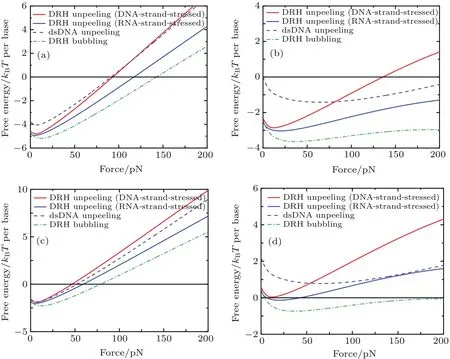
Fig.4.Plots of free energy per base pair of unpeeled and bubbled DRH relative to((a),(c))double-helix form DRH and((b),(d))S-form DRH for((a),(b))extremely GC-rich sequence and((c),(d))extremely AT(u)-rich sequence.
After examining the sequence effect,we further investigate how the temperature affects the stabilities of different forms of DRHs.To show the temperature effect more clearly,we calculate the force-temperature phase diagrams for both DRH and DNA.Here we choose the DNA-strand-stressed DRH as an example because this template is more generally used in the experiments(i.e.,in most of experiments,the DNA strand of DRH is often the tethered strand because labeling DNA strand with linkers is much easier than labeling RNA strand).To obtain the force-temperature phase diagrams,we calculate the free energy differences from Eqs.(8)-(13)at different temperatures,and then determine the unpeeling force by comparing the stabilities of different forms of DRH.The transition forces from double-helix form to S-form at different temperatures are calculated based on Zhang et al.’s measurements,where they found the transition force changes linearly with temperature and the slope is~0.12 pN/K for DNA and~0.23 pN/K for DRH.The final results are shown in Fig.6.It can be seen that at low temperature,when force increases,both DRH and DNA first change from double-helix form to S form and then start to be unpeeled.As temperature increases,the unpeeling gradually becomes more favored and occurs at a lower force.At the temperature above the triple point,both DRH and DNA will start to be unpeeled directly from doublehelix form without transforming into the S-form first.Comparing with the DNA,the triple point of DRH occurs at a low temperature(~ 28°C),indicating that unpeeled DNA-str ands tressed DRH is more sensitive to temperature and easier to happen.This may also explain why it is easier to find nonhysteric B-S transition for DNA even at room temperature[28]while to obtain the transition from the non-hysteric double helix form to S form for DRH;Zhang et al.carried out their experiments under a much lower temperature,i.e.,10°C.
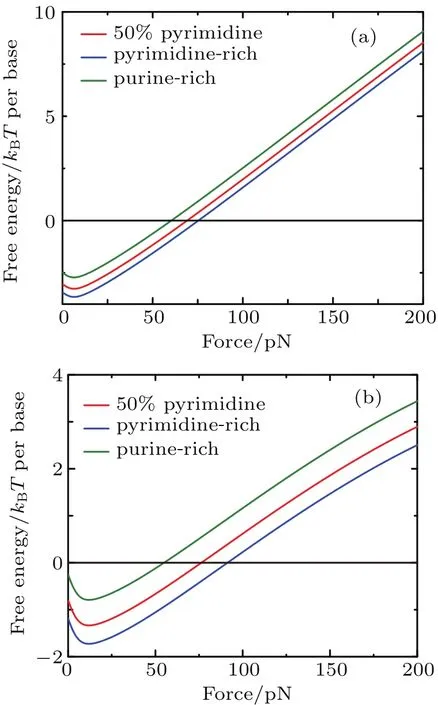
Fig.5.Free energy per base of unpeeled DRH relative to(a)double-helix formand(b)S-form for different pyrimidine content in DNA strand of DRH..
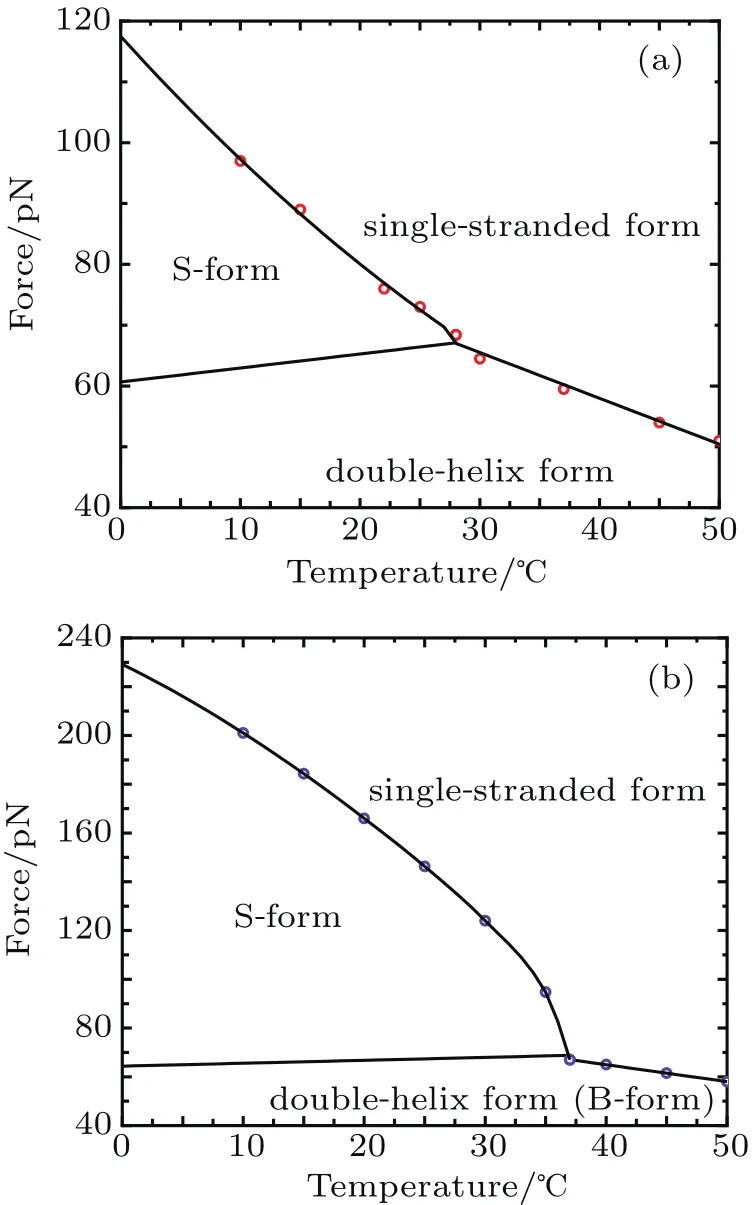
Fig.6.Force-temperature phase diagram of(a)DNA-strand-stressed DRH and(b)double-stranded DNA,both for 50%GC and pyrimidine content under 1-M NaCl condition.Circles denote calculated unpeeling force.
Finally,to better understand the hysteresis in the forceextension curves measured in DRH stretching/relaxation experiments,we resort to a kinetic model to simulate the stretching and relaxation process of a DNA-strand-stressed DRH molecule with a nick at the end(n0=0).The simulation condition is the same as the above,i.e.,at 25°C under 1-M NaCl buffer condition.Figure 7(a)shows the simulated force-extension curves for both stretching and relaxation process at different pulling rates with the λ-DNA-homologous sequence.For the stretching process,it shows that the pulling rate actually has little influence on the force-extension curves in the transition region from double-helix to S form.Instead,the later occurring in the unpeeling process is more significantly affected by the pulling rate.The higher pulling rate finally causes the complete unpeeling to finish at a higher force,which is in accord with the simulated results for the pulling rate influence on unpeeling the dsDNA.[29]Notice that the abrupt force jumps during the unpeeling,which is similar to the “stick-slip”motion seen during DNA unzipping.[30]For the relaxation process,it shows that the higher relaxing rate will make the complete reannealing reached later.The overall hysteresis increases with pulling rate increasing.However,the hysteresis in the transition region between double helix form and S form obtained from our simulation is small in comparison with that observed from the experiment,which may be due to the fact that we have not considered the effect from the secondary structure formation in the relaxed ssRNA strand in the current model.
Finally,in the simulation,we can also compare the stretching and relaxation processes at different temperatures as shown in Fig.7(b).It can be seen that with temperature increasing,the unpeeling force drops and the hysteresis becomes more obvious in the transition region from the double-helix to the S form but less signi ficant in the later unpeeling region.Moreover,when the temperature is even higher than the triple point,the transition from the double-helix to the Sform totally disappears and only unpeeling the DRH is observed.The hysteresis between stretching and relaxation under this condition is also different from those obtained at temperatures lower than the triple point.Clearly,these results demonstrate that the temperature effects on the kinetics of DRH stretching and relaxation are dramatic.
4.Conclusions
We use a thermodynamic theory to analyze the free energy and competitions among different processes during mechanically stretching a DRH molecule.These results are also compared with those of the DNA.
First,without considering the sequence effect,our calculation shows that the DNA-strand-stressed DRH is easier to unpeel than the dsDNA while RNA-strand-stressed DRH remains,for it is the hardest to be unpeeled in all these three molecules.In addition,the bubbling is always less favored than unpeeling or forming the S-form DRH under all our simulation conditions.
Then in consideration of the sequence effect,our calculation shows that increasing GC content in DRH can significantly increase the stability of the molecule while increasing purine content in the DNA strand of DRH reduces the stability of the molecule.Moreover,for the AT-rich and purinerich sequence,unpeeling always happens before the transition from the double-helix to the S form,while for the GC-rich and pyrimidine-rich sequence,the opposite scenario happens.In addition,in all cases,the bubbling is always the least favored even for the AT-or purine-rich sequence within our simulated force range.
Our calculation also demonstrates that the temperature plays a signi ficant role in determining the relative stabilities of various forms of DRH and DNA.If the temperature is lower than the triple point in the force-temperature phase diagram of DRH and DNA,as the force increases,both DRH and DNA will change from double-helix form to S form first and then start to be unpeeled later.However,if the temperature is beyond the triple point,both DRH and DNA will not undergo the transition to the S from.Instead,they directly start to be unpeeled from the double-helix form during stretching.It is noticed that the temperature at the triple point for DRH with 50%GC and pyrimidine content is only 28°C,much lower than that for DNA with the homologous sequence(~ 37°C),suggesting that unpeeling the DRH is more sensitive to the temperature and easier to occur at room temperature than unpeeling the DNA.
Further,using the kinetic model,we simulate the forceextension response of a DRH molecule during its stretching and relaxation process under different pulling rates and temperatures.Our simulation shows both the pulling rate and the temperature affect the overstretching kinetics significantly.The higher pulling rate generally leads to the larger unpeeling force and overall hysteresis.In contrast,temperature has a more important influence on DRH overstretching kinetics.For example,increasing temperature will greatly lower the unpeeling force.Moreover,because the S-DRH cannot be formed as the temperature exceeds the triple point,the stretching and relaxation process will exhibit different features when the temperature is below or above the triple point.
In summary,our work provides a detailed description of the thermodynamic and kinetic properties of the overstretching transitions of DRH.The calculated results also allow direct comparisons with single molecule stretching experiments.We thus expect it to be a useful guide for the future study of the overstretching thermodynamics and kinetics of DRH under various conditions.The results here may also help gain an insight into other DRH-associated biological processes,such as the R-Loop formation during transcription.[31,32]
Acknowledgment
We want to thank Prof.Jie Yan in National University of Singapore for very helpful discussion.
- Chinese Physics B的其它文章
- influence of carbon coating on the electrochemical performance of SiO@C/graphite composite anode materials?
- Spin glassy behavior and large exchange bias effect in cubic perovskite Ba0.8Sr0.2FeO3-δ?
- Aging mechanism of GaN-based yellow LEDs with V-pits?
- Magnetotransport properties of graphene layers decorated with colloid quantum dots?
- Temperature-dependent subband mobility characteristics in n-doped silicon junctionless nanowire transistor?
- Nonlocal effect on resonant radiation force exerted on semiconductor coupled quantum well nanostructures?

